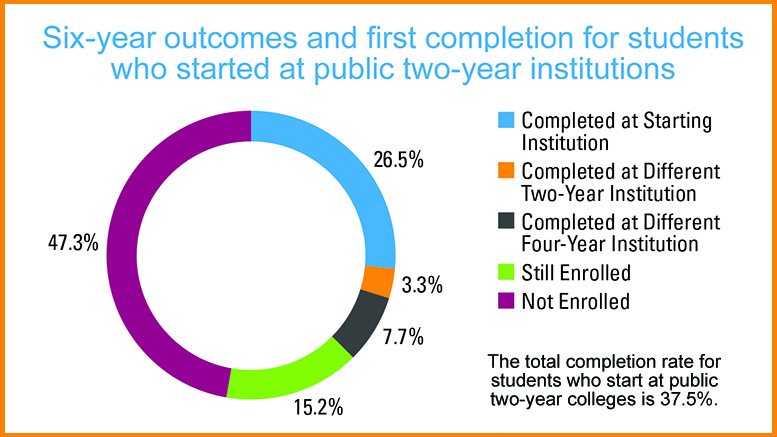Almost 38 percent of students who began at a public two-year institution completed a degree in six years, according to a new study by the National Student Clearinghouse (NSC) Research Center that tracked a cohort of students at public and private two- and four-year colleges and universities from 2011 to 2017.
Students who started at private four-year nonprofit institutions had the highest completion rates (76 percent), followed by students at public four-years (64.7 percent), public two-years (37.5 percent) and private four-year for-profits (35.3 percent).
Of public two-year college students who completed, about 70 percent did so at their starting institution, while approximately 30 percent completed at a different institution, according to the study.
Compared to the 2010 cohort, completion was down among the 2011 cohort, from 39.3 percent, regardless of whether the completions occurred at a two-year or a four-year institution. However, the NSC Research Center notes that the decline is due to a change in definition: dual-enrollment high school students were excluded from the 2011 cohort.
Without the exclusion, the completion rate would have increased slightly, to 40.1 percent, the report said.
Half ‘stop out’
Almost half of the students who began at a public two-year institution were no longer enrolled after six years, according to the study. About 15 percent were still enrolled. Rates of “stop out” — students who had earned no degree or certificate, and had no enrollment activity during the final year of the study period — were the highest (54.1 percent) at private four-year for-profit institutions, followed by public two-year institutions (47.3 percent).
Exclusively full-time public two-year students had the highest proportion of completions and lowest proportion of stop-outs, according to the study. The rate at which students were still enrolled after six years was higher among those with mixed enrollments than their full-time or part-time counterparts.
Of all students who started at public two-year institutions, about 15 percent completed at a four-year institution, including those who did so with and without receiving a two-year credential first.
Breaking down the data
In terms of race and ethnicity, about a quarter of Asian students who started in public two-year institutions and 20 percent of white students completed at a four-year institution. The percentages were much lower for black and Hispanic students: fewer than one in 10 black students and one in eight Hispanic students completed at a four-year institution (8.6 percent and 12.7 percent, respectively).
When disaggregated by race, ethnicity and age, the NSC Research Center said a unique pattern appears for black students: adult learners have higher total completion rates than traditional-age students (by 3.7 percentage points). The reverse is true for all other racial and ethnic groups, with the advantage for traditional age students ranging from 4.0 points for Hispanics to 10.7 points for Asian students.

